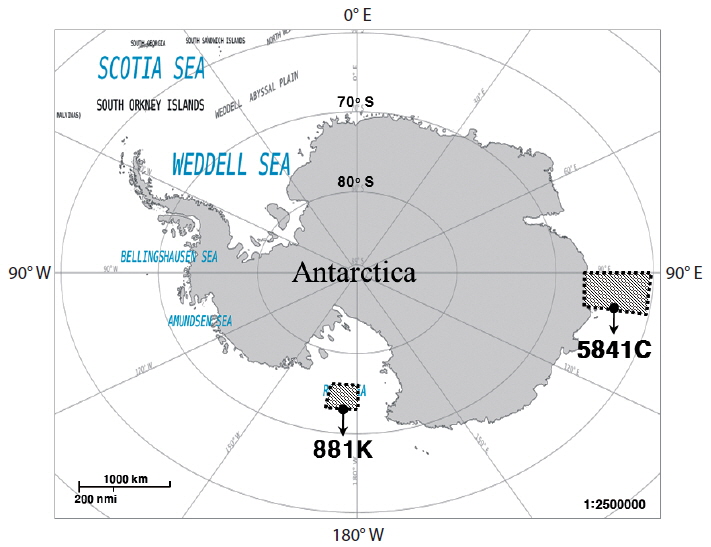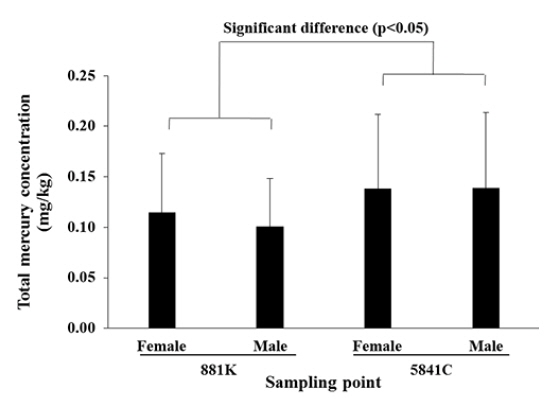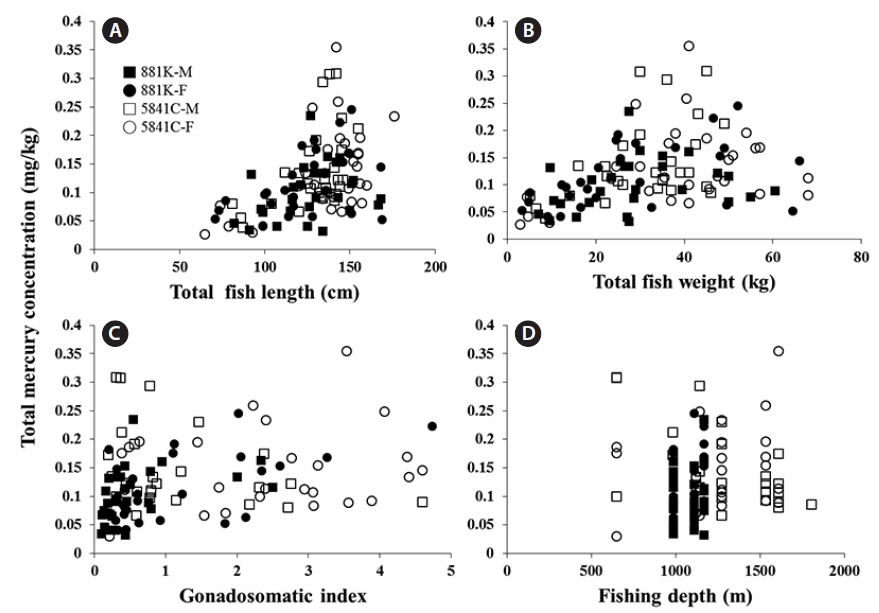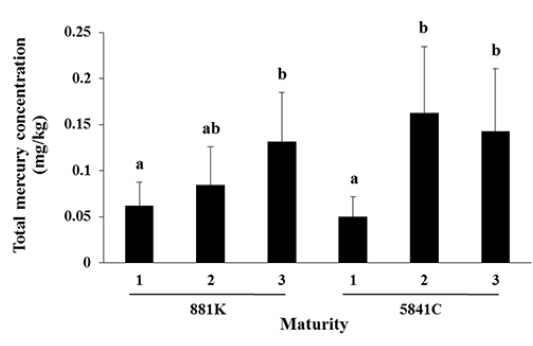



The cod icefish species internationally known as the toothfish can be classified into the Antarctic toothfish
Since the 1990s, demand for Patagonian toothfish for human consumption has increased markedly in the United States and Asia, including Japan, because of its good texture and abundant nutrition (Cascorbi, 2002). For this reason, illegal fishing was rampant, exceeding five times the catch limits set by CCAMLR (CCAMLR, 2002). Therefore, since 1996, in order to prevent overfishing of the Patagonian toothfish, CCAMLR has considered the use of the Antarctic toothfish as an alternative.
Although the Antarctic toothfish can substitute for the Patagonian toothfish, there has been no detailed safety assessment of the species as a food source. In the case of mercury, bioaccumulation and biomagnification can occur through the aquatic food chain because its inorganic form is biologically transformed in aquatic environments (Carrasco et al., 2011; Jaeger et al., 2009). Consequently, the human health implications of eating seafood with potential mercury contamination are of concern, as mercury is an element of special concern around the world. For consumption safety, the United States Food and Drug Administration (US FDA, 2010) has monitored mercury concentrations in fish since 1990. In addition, the maximum permissible levels of total mercury in fish in Australia and New Zealand (Food Standards Australia New Zealand; FSANZ, 2004), the European Community (EC, 2006), Canada (Health Canada, 2007), and Japan (Japan External Trade Organization; JETRO, 2011) were used to screen out contaminated fish samples.
In the present study, the total mercury concentrations in muscle tissue of Antarctic toothfish collected from the small scale research units (SSRUs) 881K and 5841C on the Antarctic coast were determined. Comparison analysis of total mercury concentration in accordance with biological variation (sex, maturity, total fish length, total fish weight, gonadosomatic index (GSI), and fishing depth) was carried out. In addition, a potential risk assessment of the total mercury in this fish was discussed for its possibility as a safe seafood.
Field sampling was carried out in the SSRUs 881K (Latitude: 75.38.10°S–75.41.76°S, Longitude: 173.19.10°W–173.24.43°W) and 5841C (Latitude: 65.25.62°S–65.38.63°S, Longitude; 90.15.78°E–90.53.74°E) and the sampling locations are shown in Fig. 1. After obtaining approval for experimental fishing from CCAMLR, the samples used in this study were caught in cooperation with the National Institute of Water and Atmospheric Research (New Zealand) from December 2011 to March 2012.
During the experimental fishing, a total of 113 Antarctic toothfish were caught from both SSRUs. The fish were caught at depths ranging from 600-1,800 m. After sampling, the total fish lengths and weights were 71-169 cm and 3.2-66 kg from 881K and 65-176 cm and 2.8-83 kg from 5841C. These macroscopic values for Antarctic toothfish were similar to Horn’s data (2002). These results suggested that the ages of these Antarctic toothfish ranged from 10 to 35 years. In addition, gonad weights were measured for calculation of GSI. All of these values were used for comparison analysis with total mercury concentration.
After sampling, the sex, maturity, total fish length, total fish weight, GSI (gonad weight/total fish weight × 100), and fishing depth were recorded for 55 samples caught in 881K and 58 samples caught in 5841C. The classification of maturity stages followed Kock and Kellerman’s methodology (1991). Maturity stages of toothfish were based on ovarian (1. Immature, 2. Maturing virgin or resting, 3. Developing, 4. Gravid, 5. Spent) and testis (1. Immature, 2. Developing or resting, 3. Developed, 4. Ripe, 5. Spent) cycles. Muscle tissue samples were collected from Antarctic toothfish and homogenized for total mercury analysis. All samples were kept at –20°C until further analysis.
Total mercury concentrations in homogenized samples were measured directly, in triplicate, with a combustion gold amalgamation method using a direct mercury analyzer (DMA-80, Milestone, Milano, Italy). The blanks, calibration standards, and certified reference materials (CRMs) were also analyzed using the same methods. The standards SRM 1566b (National Institute of Standards and Technology, Gaithersburg, MD, USA) and DORM-4 (National Research Council, Nova Scotia, Canada) were used as CRMs for accurate results. The concentrations of total mercury were expressed in micrograms per gram of wet weight sample. For operation of the analyzer, optimum conditions of drying (at 650°C, for 90 s), decomposition (at 650°C, for 180 s), and amalgamation (at 850°C, for 12 s) were applied. All data were evaluated with appropriate software (Easy-DOC3 for DMA, Ver. 3.30, Milestone, USA)
All data were analyzed in triplicate and subjected to analyses of variance (ANOVA) at
The accuracy of the heavy metal analysis method was assessed using SRM-1566b and DORM-4 as CRMs. The quantitative recoveries of the CRMs ranged from 96.4% to 100%, which was within the acceptable values recommended by AOAC International (2002).
After analysis, the total mercury concentrations in Antarctic toothfish were 0.115 ± 0.058 mg/kg (females) and 0.101 ± 0.047 mg/kg (males) for SSRU 881K, and 0.138 ± 0.074 mg/kg (females) and 0.139 ± 0.075 mg/kg (males) for 5841C (Fig. 2). After statistical analysis, no significant differences were observed between male and female samples; however, the total mercury concentrations from 881K and 5841C appeared to be significantly different (
For analysis of the relationship between biological variation and total mercury concentration, the PCCs were calculated (Fig. 3). In this study, the mercury concentrations were significantly positively correlated with total fish length (PCC: 0.45**), weight (PCC: 0.396**), and GSI (PCC: 0.263**) (
[Table 1.] Recovery of certified reference materials (CRM)

Recovery of certified reference materials (CRM)
In Korea, although consumption of toothfish has increased, it is not yet widely recognized as a seafood source. Moreover, there are no statistical data on the daily intake of toothfish. Therefore, for risk assessment, the daily intake of toothfish was estimated based on the daily intake of mackerel in Korea. According to Joo et al. (2010), mackerel is popular in Korea—the average daily intake is 7.2 g/day. In the risk assessment results, the total mercury body exposure rate through intake of Antarctic toothfish was between 0.097 and 0.0117 μg/kg body weight (b.w.)/week, which is 2.125-2.9% of the Provisional Tolerable Weekly Intake (PTWI). In addition, the total mercury body exposure rate through intake of Patagonian toothfish was between 0.193 and 0.739 μg/kg b.w./week, 4.825-18.475% of the PTWI (Table 2). Thus, although a higher total mercury body exposure rate was shown for the Patagonian toothfish, no health problems would be caused by mercury ingestion through either species.

The estimated weekly intake of total mercury from toothfish Dissostichus mawsoni compared with the PTWI set by JECFA
In conclusion, heavy metals accumulate in fish through the food chain after being discharged into the environment from pollution sources. Consequently, human health has been threatened by potentially heavy-metal-contaminated food. Thus, measurements of pollution levels in fish must taken into consideration to assess risk. In this study, the Antarctic toothfish was evaluated as a potential safe food source by measuring total mercury contents. The total mercury concentration in Antarctic toothfish ranged from 0.101 ± 0.047 mg/kg to 0.139 ± 0.075 mg/kg. The total mercury concentration was positively correlated with total fish length, weight, GSI, and maturity. Therefore, mercury accumulation in this fish is positively correlated with fish size and maturity, suggesting that larger or more mature fish represent a greater risk to con-sumers. However, the total mercury body exposure rate for Antarctic toothfish ranged from 2.125% to 2.9% of the PTWI. Therefore, the Antarctic toothfish could be used as a potential safe food source as a replacement for the Patagonian toothfish.





